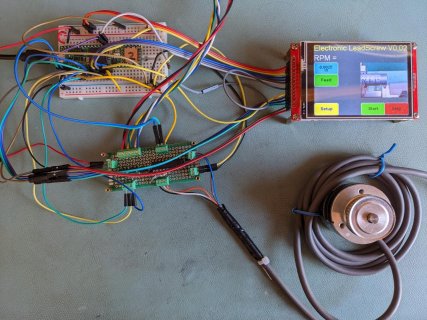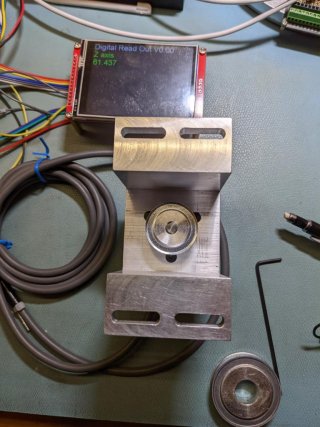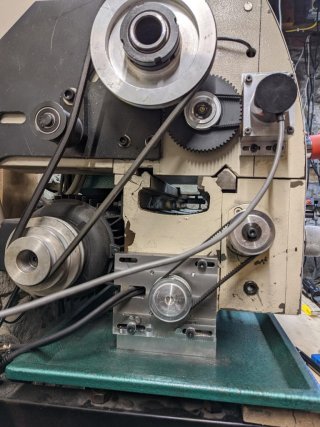#include "stepper_n_encoder_v2.h"
void doincrement(bool adir);
//// imperial 32 TPI
// int N = 293;
// int D = 2000;
//// imperial 8 TPI
// int N = 293;
// int D = 500;
//// imperial 6 TPI
// int N = 781;
// int D = 1000;
// Note: 17 May 2022, N & D were calculated off line. The value of microsteps is embedded in the ratio. To
// add one's own feeds or threads, we need to calculate using the required # of microsteps! This functionality
// is not in the code base yet.
#ifdef imperial
uint16_t myidx = 1;
float TPI = impthread[myidx].tpi;
int N = impthread[myidx].N;
int D = impthread[myidx].D;
int ustep = impthread[myidx].ustep; // added for future capability
float tenpitch_error_percent = impthread[myidx].error;
#endif
OneShotTimer t1(PIT); // for stepper pulse
OneShotTimer t2(PIT); // for measuring speed.
// XPT2046_Touchscreen ts(TOUCH_CS);
// ILI9341_t3n tft = ILI9341_t3n(TFT_CS, TFT_DC, TFT_RST, TFT_MOSI, TFT_SCK, TFT_MISO);
void onEncoderChanged(int value, int delta)
{
// volatile int mydelta = -delta;
if (delta > 0)
{
if (delta > 1)
{
Serial.printf("fault! delta = %i\n", delta);
errorcount += 1;
}
else
{
// delta = 1
myacc = myacc + delta * N;
if (myacc >= D) // works for positive accumulation only
{
myacc = myacc - D;
mydir = CCW;
doincrement(mydir);
}
}
}
if (delta < 0)
{
if (delta < -1)
{
Serial.printf("fault! delta = %i\n", delta);
errorcount += 1;
}
else
{
// delta = -1
myacc = myacc + delta * N;
if (myacc <= D)
{
myacc = myacc + D;
mydir = CW;
doincrement(mydir);
}
}
}
val1 = value;
//Serial.printf("Count = %i\n", value);
}
// void onEncoderError() don't know how it is used, nor what to look for!
void pulseme() // turns off stepper pulse after time out
{
digitalWriteFast(PUL, LOW);
// digitalWriteFast(LED_BUILTIN, LOW);
}
void doincrement(bool adir) // sets direction and turns on stepper pulse
{
digitalWriteFast(DIR, adir); // set direction
delayNanoseconds(100); // can improve stepper speed by doing this, but is dangerous...
digitalWriteFast(PUL, HIGH);
t1.trigger(steplen); // switch off after steplen us (2us)
}
void myms() // xxms timer callback for estimating spindle speed and step rate
{
val2 = (uint32_t)SpindleEnc.getValue(); // read encoder for current position
// we know the time was 20 ms
cps = 50.0f * ((int)val2 - valstart) / (float)encoder_resolution;
; // rev per second 50 = 1/0.02
sps = cps * (float)encoder_resolution * (float)N / (float)D; // steps/second
myrpm = -cps * 60.0f;
timeout = true;
}
void readconsole()
{
if (Serial.available())
{
int incomingByte = Serial.read(); // read the incoming byte
char c = (char)incomingByte;
// Parse the command.
if ((c != '\n') & (c != '\r'))
{
Serial.println();
Serial.print(F("key pressed: "));
if (c == ' ')
Serial.println(F("[space]"));
else
Serial.println(c);
if (c == 'r') // reset the counter
{
SpindleEnc.setValue(0); // wait til we get the right syntax!
Serial.printf("Reset spindle counter to 0\n");
} // add more commands as you see fit
}
}
}
void setup()
{
while (!Serial && millis() < 4000)
;
if (CrashReport)
Serial.println(CrashReport);
for (int i = 5; i < 8; i++) pinMode(i, OUTPUT); // init these pins to outputs
t1.begin(pulseme); // set up t1 callback function
t2.begin(myms); // set up t2 callback function
digitalWriteFast(DIR, CW); // sets direction of rotation LOW =CW, HIGH=CCW
digitalWriteFast(ENA, LOW); // active low signal, enables the stepper controller
// Use luni's SW encoder
SpindleEnc.begin(0, 1, CountMode::full); // encoder on pins 0,1 count all e3dges of the quadrature signal
SpindleEnc.attachCallback(onEncoderChanged);
myacc = 0; // Bresenham accumulator
oldrpm = 0.0f;
timeout = true; // so we start measuring speed right away
// if (0){ // prevent all tft writess for debug!!!
// if (!initMyDisplay(3))
// {
// Serial.println("Display failed to initialize");
// while(1);
// }
// if (!mainscreen())
// {
// Serial.println("Failed to send first message to display");
// while(1);
// }
// }
errorcount = 0;
displaycount = 0;
first = true;
// Eventually all this will be selected via the touch panel
Serial.printf("TPI = %3.1f, usteps/step = %i\n", TPI, ustep);
Serial.printf("N = %i, D = %i\n", N, D);
Serial.printf("Ten pitch error as per cent of pitch = %4.2f\n", tenpitch_error_percent);
}
void loop()
{
if (timeout) // if no timeout, skip this
{
timeout = false; // determine how many counts we get in 20ms, this is the base for a speed estimate
t2.trigger(20ms); // set timer to go off in 20ms
valstart = val1; // save current position
}
if ((myrpm == 0.0f) && (first))
{
Serial.printf("%7.1f%\tRPM\n", -myrpm); // there's a zero bug of some sort
// displayRPM(-myrpm);
first = false;
}
if (myrpm != 0)
{
first = true;
Serial.printf("pos: %d, RPM: %7.1f\n", SpindleEnc.getValue(), myrpm);
// displayRPM(myrpm);
}
delay(200);
// readconsole();
}






